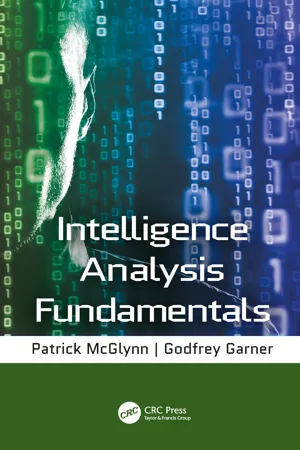
- 315 pages
- English
- ePUB (mobile friendly)
- Available on iOS & Android
Intelligence Analysis Fundamentals
About this book
There are a limited number of intelligence analysis books available on the market. Intelligence Analysis Fundamentals is an introductory, accessible text for college level undergraduate and graduate level courses. While the principles outlined in the book largely follow military intelligence terminology and practice, concepts are presented to correlate with intelligence gathering and analysis performed in law enforcement, homeland security, and corporate and business security roles. Most of the existing texts on intelligence gathering and analysis focus on specific types of intelligence such as 'target centric' intelligence, and many of these, detail information from a position of prior knowledge. In other words, they are most valuable to the consumer who has a working-level knowledge of the subject.
The book is general enough in nature that a lay student—interested in pursuing a career in intelligence, Homeland Security, or other related areas of law enforcement—will benefit from it. No prior knowledge of intelligence analysis, functions, or operations is assumed. Chapters illustrate methods and techniques that, over the years, have consistently demonstrate results, superior to those achieved with other means. Chapters describe such analytical methods that are most widely used in the intelligence community and serve as recognized standards and benchmarks in the practice of intelligence analysis. All techniques have been selected for inclusion for their specific application to homeland security, criminal investigations, and intelligence operations.
- Uses numerous hands-on activities—that can easily be modified by instructors to be more or less challenging depending on the course level—to reinforce concepts
- As current and active members of the intelligence community, the authors draw on their decades of experience in intelligence to offer real-world examples to illustrate concepts
- All methodologies reflect the latest trends in the intelligence communities assessment, analysis, and reporting processes with all presented being open source, non-classified information
- As such, the non-sensitive information presented is appropriate—and methods applicable—for use for education and training overseas and internationally
- Military-style collection and analysis methods are the primary ones presented, but all are directly correlated intelligence to current concepts, functions and practices within Homeland Security and the law communities
- Covers the counterterrorism environment where joint operations and investigative efforts combine military, private sector, and law enforcement action and information sharing
The book will be a welcome addition to the body of literature available and a widely used reference for professionals and students alike.
Frequently asked questions
- Essential is ideal for learners and professionals who enjoy exploring a wide range of subjects. Access the Essential Library with 800,000+ trusted titles and best-sellers across business, personal growth, and the humanities. Includes unlimited reading time and Standard Read Aloud voice.
- Complete: Perfect for advanced learners and researchers needing full, unrestricted access. Unlock 1.4M+ books across hundreds of subjects, including academic and specialized titles. The Complete Plan also includes advanced features like Premium Read Aloud and Research Assistant.
Please note we cannot support devices running on iOS 13 and Android 7 or earlier. Learn more about using the app.
Information
1Defining Intelligence Analysis
Introduction
What Is Intelligence?
What Is Intelligence Analysis?
Origins
Differences
- Terms of information or data sources (e.g., human, imagery, signals, open source)
- Who the intelligence product end users/consumers are (e.g., business intelligence, military intelligence, political intelligence)
- Number of sources used in production (e.g., single source, all source)
- Types (e.g., strategic, tactical, scientific/technical)
- Product usability aspects (e.g., actionable vs. nonactionable)
Commonalities
Table of contents
- Cover
- Half Title Page
- Title Page
- Copyright Page
- Contents
- Preface
- About the Authors
- Chapter 1 Defining Intelligence Analysis
- Chapter 2 The Intelligence Cycle
- Chapter 3 Thinking about Thinking
- Chapter 4 Perception and Deception
- Chapter 5 Knowing Your Audience
- Chapter 6 Analytical Communication
- Chapter 7 Defining the Problem
- Chapter 8 Generating the Hypothesis
- Chapter 9 The Collection Process
- Chapter 10 Analytical Tradecraft
- Chapter 11 Cognitive Traps for Intelligence Analysis
- Chapter 12 Probability Estimation
- Chapter 13 Creating an Analytical Plan
- Chapter 14 Preparing and Conducting Intelligence Briefings
- Chapter 15 Best Practices
- Chapter 16 Operations Security (OPSEC)
- Index